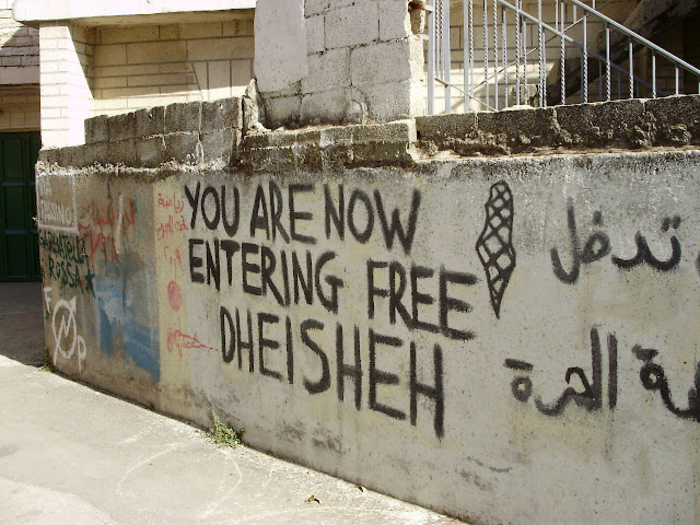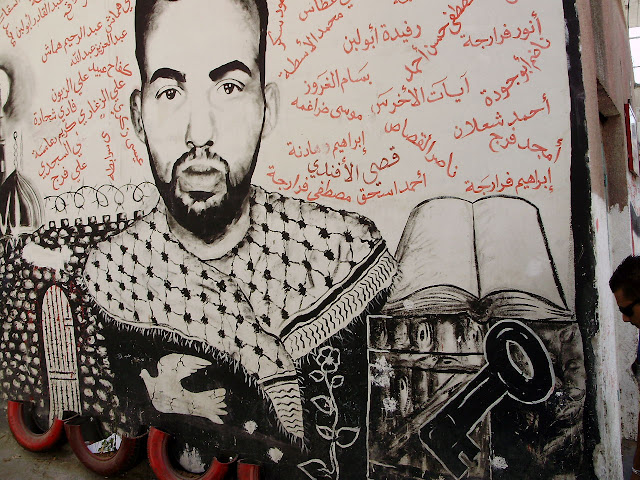An article in the Guardian by Oliver Wainwright, the outlet’s architecture critic, reports on a new exhibition at the Mosaic Rooms in London asserting that Dheisheh refugee camp in the West Bank should be declared a UNESCO World Heritage Site.

The exhibit is produced by an outfit called the Decolonising Architecture Art Research collective (DAAR), which argues, the article notes, for the location’s “outstanding universal value” as “the site of the longest and largest living displacement in the world”.
What the Guardian doesn’t say in the article (“As important as the Taj Mahal? The Palestinian refugee camp seeking Unesco world heritage status”, Oct. 14) is that DAAR supports the unlimited ‘right of return’ for millions of the descendants of the original Palestinian refugees.
After providing more information on the exhibit, Wainwright attempts to provide background on the ‘refugee camp’:
Established in 1949 to house more than 3,000 Palestinians expelled from their villages by Jewish militias in the Arab-Israeli war, Dheisheh has since swelled to accommodate 15,000 people. It began as a tent encampment, laid out on a military grid across an undulating stretch of land leased to the United Nations Relief and Works Agency (UNRWA) by the Jordanian government (which still technically owns the land).
First, as even Palestinian officials have acknowledged, Jews still “technically own the land”, as Dheisheh was built on JNF land lost during the 1948 War. Further, it’s not accurate that the 3,000 original inhabitants of the camp had all been “expelled”, as the Guardian claims. For instance, many of the original inhabitants came from the village of Beit Jibrin, 20 km northwest of Hebron. As even anti-Israel sources acknowledge, they fled (but weren’t expelled) during fighting between the Haganah and Egyptian forces.
Wainwright continues:
Dheisheh is the product of being forced to live in perpetual limbo, with the eternal hope of one day leaving, creating what Petti and Hilal call a state of “permanent temporariness”. The neighbourhoods are still loosely arranged according to the villages where the refugees came from, and the families cling to the dream of returning home to their ancestral lands…
…
“There is a widespread feeling among Palestinian refugees that if you consider the camp your home, you will jeopardise the right of return,” says [a resident]
This is a good illustration of the lies and egregious double standards feed the entire ‘refugee’ narrative. Palestinians, unlike Jewish refugees from Arab lands, and, in fact, every other refugee group in the world, are granted refugee status in perpetuity to each subsequent generation, regardless of whether they already enjoy full citizenship in another country, as millions do.
Also, Dheisheh is located within Bethlehem, a city (within Area A of the West Bank) under complete control of the Palestinian Authority. There’s no reason, other than to cynically perpetuate the ‘refugee’ issue, why PA officials couldn’t expel UNRWA, incorporate the camp into Bethlehem’s municipal boundaries and govern the residents exactly as they do the rest of the city.

Instead, the Palestinians of Dheisheh, who, as with nearly the entire ‘refugee’ population (5.6 million per UNRWA), are merely descendants of the 1948 refugees, are fed the fantasy that they’ll one day ‘return’ to (Israeli) territory where their ancestors once lived. Such a plan would, via demographics, do what the Palestinians and Arab states were unable to do through war – erase the only majority Jewish state on the globe.
Palestinians like those in Dheisheh are “forced to remain in perpetual limbo” by the PA and Western enablers of the refugee swindle.
In the final paragraph of the article, Wainwright laments the fact, despite the work of DAAR, that Dheisheh will never become a UNESCO heritage place:
Their work is made all the more poignant by the political impossibility of its goal. Of course their nomination can never reach Unesco – as an extraterritorial place, carved out from a state sovereignty, home to a stateless people, there is no state party that would ever present it.
In fact, earlier in the piece, the Guardian quoted DAAR’s director similarly complaining that “world heritage sites can only be nominated by nation states”
In both passages, Guardian readers are grossly misled. ‘Palestine’ (the Palestinian Authority), though not a “nation-state”, has, since 2011, enjoyed full member status at UNESCO, and could, if they wanted to, present such a proposal. Recall that, in 2016, UNESCO approved a Palestinian proposal that erased Jewish ties to the Temple Mount.
Though the specific claim by DAAR’s director about the political impossibility of their call to declare Dheisheh a UNESCO World Heritage Site is untrue, within their deceptive rhetoric lies some insight. Their implicit admission that the effort can’t succeed suggests that the exhibit is merely performative – an addition to the vast body of anti-Israel propaganda disguised as art or scholarship that’s disseminated in the UK – rather a serious political campaign.
Unsurprisingly, the Guardian critic loved the performance.
Related Posts
Guardian buries inconvenient fact about British antisemitism rise





The UNESCO thing is simply another for the growing “You can’t make this up” series of amazing facts about the Palestinians.